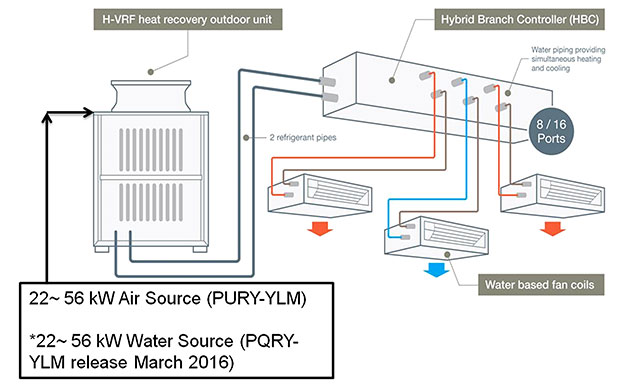Mitsubishi relaunches Hybrid VRF
2nd December 2015UK: The impact of the F-gas regulations and customer concerns over EN378 has prompted Mitsubishi Electric to relaunch its Hybrid VRF system.
First launched in 2013, the Hybrid VRF is said to combine the advantages of chiller technology with the flexibility and efficiencies of traditional VRF. While Mitsubishi Electric admits that the original Hybrid VRF had its limitations, the new, second generation, City Multi Hybrid VRF system is said to offer the same flexibility of design and installation that City Multi VRF has become renowned for. In addition, it still provides centralised control, individual operation, and simultaneous heating and cooling with heat recovery. It is based on the standard City Multi YLM outdoor unit backed by four HBCs and four indoor units in ducted, cassette and floor-standing variants.
Mitsubishi’s Hybrid VRF system operates without using refrigerant in occupied spaces, removing the need for leak detection equipment and allowing more properties to take advantage of manageable phased installation through the system’s modular two-pipe design.
“There is a lot of legislation impacting on the use of energy in the built environment and at the same time, there is a drive to look for new refrigerants to mitigate any harm to the environment,” explained Sebastien Desmottes, product marketing manager for the company.
“This will have a major impact on the industry over the next 15 years but in the meantime, we have to deliver systems that provide customers with a comprehensive choice to help them reduce emissions and running costs whilst meeting current and future legislation.
“BS EN378 in particular will restrict the amount of refrigerant that can be used in occupied spaces and we believe there is now a growing market for this type of system,” added Desmottes.
At the heart of the new system is an HBC (Hybrid Branch Controller) box (pictured above), connected to an outdoor City Multi unit via traditional refrigerant piping. Between the HBC and the indoor fan coils, the system uses water piping but is still able to deliver mild air-off temperatures and a great stability of temperature all year round, supplying chiller levels of comfort to occupants.
Unlike the original design, each individual HBC can now supply heating and cooling to 16 individual indoor units – using City Multi’s two-pipe system and including options for ducted, cassette and floor-standing models. Two main HBC’s and two sub units can be connected to the same City Multi outdoor unit to deliver simultaneous heating and cooling to up to 50 individual rooms or areas.
With no refrigerant in occupied spaces, Hybrid VRF also enables simple compliance with BS EN378 and completely removes the need for leak detection in any occupied room. This technological benefit also means a low overall system refrigerant volume.
“We still see significant scope for VRF and chiller technologies but pressure on refrigerants in occupied spaces, and the need for increased levels of efficiency and performance make Hybrid VRF the ideal choice for a growing part of the sector,” added Desmottes.
Current standards restrict the use of refrigerants in buildings, with BS EN378 in particular intended to minimise possible hazards to persons, property and the environment from refrigerating systems and refrigerants. As such, leak detection must be provided if, in the case of R410A, a concentration of 0.44 kg/m3 refrigerant could be exceeded if all of the refrigerant from a system were to leak into a single room.
This legislation is particularly applicable for hotels. Generally, this limits systems to about 20kg of R410A or forces the addition of leak detection systems.
The only other option is to break larger systems down into smaller ones. Either way, says Mitsubishi Electric, an increase in cost and complexity cannot be avoided, and this is where Hybrid VRF now offers an easy solution.
“We realised that one way to reduce cost and minimise possible hazards to persons, property and the environment, would be to remove the refrigerant from occupied spaces using a water-based system,” explained Desmottes. “This Hybrid VRF system has been developed exclusively to answer this need.”
The outdoor unit behaves in much the same way as a two-pipe heat recovery VRF system with two refrigerant pipes connecting the HBC, which has been optimised to provide the same efficiency as standard VRF and offer simultaneous heating and cooling with heat recovery.
However, instead of two refrigerant pipes sending refrigerant for cooling or heating to the indoor units, hot or cold water is sent instead using either plastic or copper pipe. Efficiency is further improved from the heat-recovery defrost, enabling short defrost times with immediate return to heating.
The system is fully integrated in its control and components through the use of inverter driven pumps and flow control valves which are all built into the HBC.
“Hybrid VRF is designed specifically to deliver the function of a four-pipe fan coil chiller system with the efficiency and flexibility of modern VRF in one system,” adds Desmottes. “We expect to see BS EN378 legislation impact more on the built environment and have developed this range to answer that need”.









